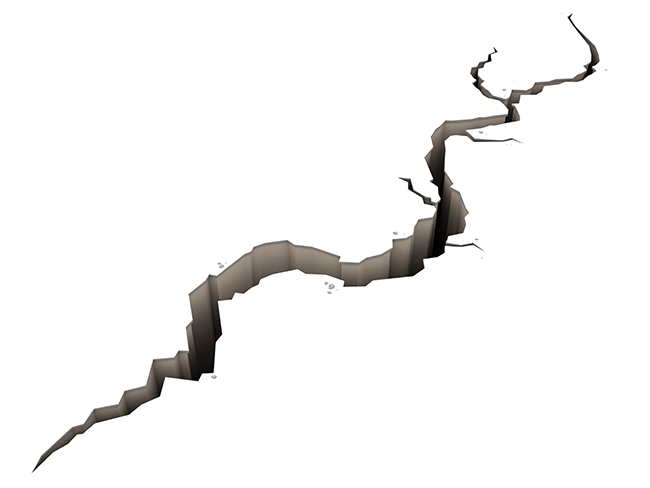
Flirting With Disaster
It’s been 20 years since the Northridge earthquake, the costliest disaster in U.S. history. And perhaps nowhere more than here in the Valley, the occasion has us thinking about the next “Big One.” Amidst the release of reports of collapse-prone concrete buildings, including dozens in the Valley, local disaster experts insist we are better prepared—but caution that we should all be ready to fend for ourselves.
-
CategoryUncategorized
-
Written byJustin Chapman
There was a loud bang…like an explosion, and Kevin Uhrich was thrown off the sofa, landing facedown on the floor as the earth shook violently. Kevin, editor of Pasadena Weekly, at the time was a reporter living in Sherman Oaks. He’d had an argument with his then-girlfriend and was sleeping on a friend’s couch that night.
“I grabbed a pillow, covered my head and crawled under the coffee table until it subsided an eternal 30 seconds or more later,” says Kevin. “After the shaking stopped, I threw on my shoes and ran out to the car. Storefront windows near the corner of Laurel Canyon and Ventura were shattered, with shards of glass strewn everywhere. A cacophony of security alarms and car horns filled the air. Power lines further down the street had fallen. Street lights were out. Portions of the street had buckled and cracked, and underground water mains had ruptured. It was surreal.”
That morning, January 17, 1994, the magnitude 6.8 Northridge earthquake shook Southern California for half a minute, killing more than 60 people, including 16 residents who lost their lives when an apartment building on Reseda Boulevard collapsed. At least 10,000 people were injured, and the quake caused more than $20 billion in damage.
Freeway ramps fell, streets cracked wide open and houses tumbled down hillsides. A total of 65,000 residential structures sustained damage.
For many Valley residents, the nightmare continued for weeks afterwards. Displaced residents, barred by police from returning to their taped-off dwellings, lived in “tent cities” in local parks. Thousands of aftershocks, felt as far away as Las Vegas, continued to rattle nerves.
“I was one of the very few people outside at the time, and I had the entire street to myself,” says Kevin. “It was like a scene from the twilight zone. It was as though parts of Studio City and Sherman Oaks had been bombed, and I was the only person to survive. I finally made it to our apartment, which really got whacked, and ran inside—ignoring people yelling at me to stay outside—but my girlfriend was gone. I finally found her among the other frightened tenants gathered in the parking lot, and she was okay, but all of our stuff—TV, stereo, furniture, personal items—was ruined. Our apartment building was red-tagged, and everything in our unit was destroyed.”
Since that devastating temblor, the city of Los Angeles has examined how to be better prepared and increase public safety. One of the biggest challenges has been how to deal with building safety.
The city has grappled with an affordable way to make buildings safer, an unresolved issue that was recently magnified when researchers at the University of California presented the city with a list of pre-1976 concrete buildings that could be at risk in a strong earthquake. According to the study, some of the buildings, dozens of which are in the Valley and include schools and retail stores, have a high chance of collapsing or otherwise endangering life in a major quake.
The Department of Building and Safety (LADBS) is also getting involved by trying to evaluate exactly which of the structures are the most dangerous. Researchers estimate that only 75 of the 1,500 buildings would actually collapse, but they can’t identify which 75.
City officials are also trying to figure out how to fund retrofitting the buildings, many of which are privately owned. The city can’t afford to do it; some officials are lobbying for help from the state.
“Following the Northridge earthquake, teams of engineers from the California Structural Engineers Association together with the LADBS examined and evaluated multiple damaged buildings to determine what, if any, improvements should be made to the city’s building codes to improve the performance of these building types in future seismic events,” explains Luke Zamperini, spokesperson for the LADBS.
“This effort resulted in seven retrofit ordinances being passed by the city council. Two of these ordinances were mandatory programs for damaged steel-frame buildings and all concrete tilt-up buildings. The remaining five ordinances are voluntary programs for wood-frame residential buildings, older concrete-framed buildings, and concrete or reinforced masonry buildings with wood diaphragms.”
He adds that the building, mechanical, electrical and plumbing codes are updated approximately every three years. Improving disaster response has also been addressed. However, the consensus from city officials seems to be that no matter what we do, another major earthquake could cause even more casualties and damage than the Northridge quake. And government agencies, no matter how well-prepared, will not be able to help everyone in need.
Faulty Lines
There are more than 10 major faults in Southern California capable of producing devastating earthquakes, according to research geophysicist Robert Graves, who studies earthquake seismology for the United States Geological Survey (USGS).
“It’s pretty difficult to be in Southern California and not be somewhat close to an active earthquake fault,” he says. “Clearly the closer you are to an active fault or a fault that produces an earthquake, the more the ground shakes and the more chance of damage.”
Just because the Valley bore the brunt of the last “Big One” doesn’t mean it will be exempt from the next one. Like lightning, earthquakes can strike the same place twice. Or more, for that matter.
“Since we don’t know exactly which fault will produce the next damaging earthquake, I can’t say there’s a better place or worse place ,” says Robert, “and that’s just based on the active faults that we know about. There are probably other geologic faults that are buried under the surface that have not been identified. That certainly occurred with the Northridge fault. It hadn’t been recognized as an active fault prior to that earthquake because it is what’s called a buried fault. If you’re looking at the geology on the ground, there’s no clear evidence of a fault being there.”
Close Calls
In fact, in the last year more than 300 measurable earthquakes hit Los Angeles, including the Valley, ranging from magnitude 1.5 to 4. As recently as the morning of January 17, the anniversary of the Northridge quake, a magnitude 2.6 quietly shook the Valley. That quake was centered about two miles west of Universal City at a depth of 0.1 miles, according to USGS.
“We can record down to magnitude 2 or 3, and there are some even smaller that are not even recorded,” Robert says. “There are magnitude 2.5 to 3 earthquakes each day, and well over 1,000 a year. Earthquakes really are going on all the time.”
So what, exactly, will the “Big One” be like? It depends.
“The Northridge magnitude would be called a moderate magnitude,” says Robert. “A couple of years ago there was an earthquake off the coast of Japan that was a magnitude 9 . In that sense, Northridge really was not that significant, just looking at a geologic classification.”
But because it was centered in a heavily populated area, it was more impactful.
Southern California does have faults that are capable of producing larger earthquakes, up to magnitude 8. In 1857 a magnitude 7.9 ruptured off the San Andreas Fault. Robert says that if a repeat of that quake were to occur, it would have widespread consequences.
One thing is fairly certain: At some point in the near future, there will be another magnitude 6.8 or higher. In fact, seismologists have determined that there is a 60% chance of an earthquake equal to or worse than Northridge hitting Southern California in the next 30 years.
“It is unpredictable, especially in a very specific sense, what day or what hour or what year even,” says Robert. “But in a more general sense, it’s clear we have active faults, they will produce earthquakes, they’re producing earthquakes every day of a small magnitude, and in the future they will produce large, potentially damaging earthquakes.”
Look out for #1
So are we prepared for the “Big One?” Chris Ipsen, public information officer for LA’s Emergency Management Department, says the Valley has come a long way since 1994.
“The building codes have improved since then,” he says. “After every large earthquake, engineers go out and look at how the buildings did, and they’re doing better. The Valley doesn’t have a lot of skyscrapers, so it’s probably better off than other parts of LA.”
Interestingly, Chris points out that some technological advances could hamper rather than help during an emergency. “Society is now more reliant on gadgets and devices like smartphones. We rely on telecommunications more, but we don’t have regulations as a way of seismically securing cell phone towers. We don’t know how many will be up and running after an earthquake.”
He continues, “Also, grocery stores now operate under just-in-time delivery systems.” Under that new system, grocery stores only keep a three- or four-day supply of food in their storage warehouses.
Chris says his department has developed relationships with businesses like large retailers, as well as other sectors such as financial, faith-based, manufacturing and the movie industry. “The movie industry is a big player for us because it has huge resources. We work closely with Universal. We want to have the capabilities to deploy those resources quickly.”
Despite all this, Chris emphasizes the importance of individuals being pro-active. “The better prepared people are to take care of themselves, the more we can take care of heavy-impact areas and the ones who don’t have resources. Community resilience is a big word now,” he says.
“We have a five-step program to help people get their neighborhood ready. You may not have any first responders coming in. The city has a lot of resources, but we’re just concerned that we can’t get to everybody.”
Captain Keith Scott of the LA Fire Department, who was a firefighter at the time of the Northridge quake, was less than a mile from the epicenter. He and his fellow firefighters were thrown out of bed at Fire Station 72 on De Soto Avenue and Vanowen Street.
“It was quite a big jolt,” he remembers, agreeing that much has changed since 1994. “We’ve trained many people since then. We have nationally-ranked search and rescue teams that we didn’t have before. They respond to incidents all over the world.”
Citizen Responders
Meanwhile volunteer groups are ready to spring into action. The Community Emergency Response Team (CERT), which trains civilians in emergency preparedness, was formed locally in the late 1980s.
Captain Scott serves as the CERT commander for LA, which trains 4,000 people every year. About half of those people live in the Valley.
“Our CERT program was originally developed because there was a need for a well-trained citizen workforce,” he says. “We saw a need after seeing many disasters happening throughout the world, and we took a look at what would happen in LA—that our fire department would be very taxed. We thought there was a need for citizens to be trained to take care of themselves for anywhere from three days to a week.”
The free, 17-hour CERT course—taken over seven weeks—includes fire prevention and suppression techniques, disaster medical operations, how to deal with casualties and triage, rescue operations, and disaster psychology. Getting CERT-certified is the most important thing someone can do to prepare, according to Captain Scott.
“First thing we’ll do is make sure our personnel are okay, and then we’ll get all our equipment out of the station and to a safe place so we can use it. Then we will drive around our first-in area (district responsible for). There are certain things that we’ll look for, like collapsed buildings and bridges. We’ll check places like hospitals and convalescent homes. It’s quite a comprehensive check. Unless there’s a life-threatening injury, we try not to commit ourselves to any one incident until we check everything in our first-in area.”
For instance, the collapse of Northridge Meadows Apartments, which caused the death of 16 residents, is an example of an incident that the fire department would immediately respond to. But for the less serious calls, your neighbors and even strangers may become the first responders.
Captain Scott advises stocking up on water, food, bandages, clothing, batteries and other emergency supplies and to have extras on hand for others. “The main thing you need to do is make a plan on what you’re going to do. Have a contact outside the city so you can let them know you’re okay. Put together a go-bag. Have one at home, one in your car and one at work, because you never know where you’re going to be when it hits.”
For a list of the next available CERT classes, visit cert-la.com.
Are You Prepared?
When the next big earthquake hits, expect to fend for yourself for at least a week. Basic necessities like electricity, gas and running water may not be available. And you may not be able to contact anyone for a while. Here are a few simple steps to prepare, from the California Department of Conservation.

Before an earthquake (now):
Stock up on water, food and supplies, including a first aid kit, pet food, baby food, games for kids, a battery-operated radio, extra batteries, a fire extinguisher—or an earthquake kit.
Make sure you know how to use your fire extinguisher.
Sign up for emergency alerts from your local emergency management agency.
Visit ready.gov for strategies to build an emergency kit and put a plan in place.
Get trained by your local Community Emergency Response Team. Visit fema.gov/community-emergency-response-teams to find your local CERT.

When the earthquake hits:
If you’re inside, stay inside and get under and hold onto a desk or table. If you’re outside, get into the open, away from buildings or anything that could fall on you. Cover your neck with your arms and hands.
If you’re driving, pull your car out of traffic and stop. Avoid bridges and overpasses. Stay clear of signs, trees and power lines.
Check the gas main leading to the house and shut off the power if there’s electrical damage.
Listen to the radio for updates and instructions.
If you leave your house, let someone know where you’re going.
BIG ONE-O-ONE
2-3 Earthquakes occur in Southern California every single day (Robert Graves, USGS earthquake seismologist)
10 Major fault lines that crisscross Southern California, all with the potential for producing damaging earthquakes
80,000–125,000 People temporarily or permanently displaced because of property damage following the Northridge earthquake
$25 billion Damage costs from the Northridge quake (National Institute of Standards and Technology)
$20 Price per battery at a 7-Eleven store on Devonshire after quake
60% Probability that an earthquake measuring greater or equal to 6.8 will occur in Southern California in the next 30 years
75 Estimated number of pre-1976 concrete buildings in Los Angeles that UC researchers believe would collapse in the event of a a major earthquake (University of California study)
300 Fault maps yet to be completed by the California Geological Survey, including ones for highly populated areas like LA’s Westside and the San Gabriel Valley (LA Times). And the mapping budget is about to run out—really bad news since the state’s strict earthquake building regulations only apply to faults that have been zoned by the maps. State Senator Ted Lieu (D-Torrance) has called on the legislature to provide more funding to complete the maps.
72 People dead & 11,846 People treated for quake-related injuries in LA, Ventura and Orange counties after the Northridge earthquake, (according to figures compiled by Michael Durkin and published in the state Division of Mines and Geology in 1995)











